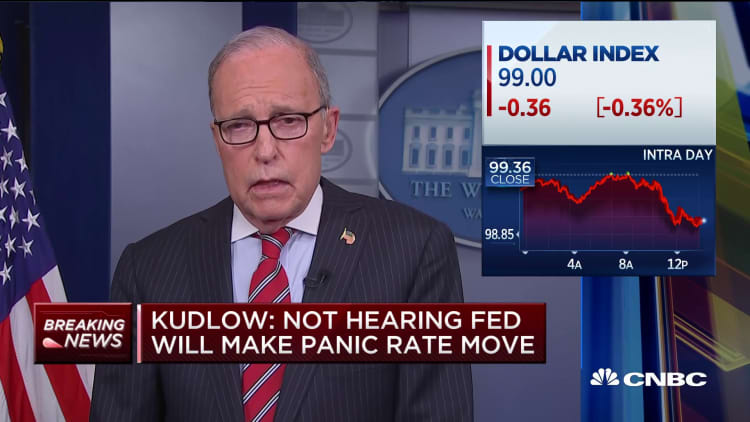The Federal Reserve and the markets are miles apart when it comes to expectations for interest rates, and that's unlikely to change anytime soon.
Traders, as indicated through futures markets, expect the central bank to cut short-term rates at least once and possibly as many as three times this year. Fed officials, on the other hand, have been unanimous and steadfast in saying they are comfortable with policy where it is now and don't see a move absent a major change in conditions.
Market fear has manifested itself in a stock market sell-off that took 1,000 points off the Dow Jones Industrial Average on Monday and nearly 3% again Tuesday afternoon.
While the Fed has seemed to capitulate to the market before, there's a pressing reason why that might not happen this time: There's little evidence rate cuts would do much good.
"The market loves a good rate cut," said Kathy Jones, chief fixed income strategist at Charles Schwab. "What I'm getting from Fed officials is sort of, 'OK everybody, calm down, we're not there yet.' Clearly, they're going to leave the door open. But the issue is monetary policy doesn't really work well in these sorts of situations."
Supply vs. demand
The current market tumult is being driven largely by fears over the coronavirus spread.
In economist terms, that's a supply shock, where the concern is that the contagion in China, the world's biggest exporter, will stall the delivery of goods globally and slow commerce.
Fed policy, though, is geared toward demand. That is, when consumers are reluctant to spend or invest, reducing the cost of capital can goose demand and get things moving again. One example is the Fed's actions after the financial crisis to reduce long-term rates so that mortgages were less costly and housing became more affordable.

In the current scenario, there's no monetary policy move that can slow a disease or open global supply lanes.
"No amount of rate cuts is going to be able to do that," said Michael Reynolds, investment strategy officer at Glenmede Trust. "What they can do is hasten the recovery after all this blows away with rate cuts. That is something that's an option for sure. But the idea that they're going to play offense on rate cuts to soften the blow on the coronavirus may be a bit premature."
The Fed cut its benchmark short-term borrowing rate three times in 2019 as part of what Chairman Jerome Powell described as a "midcycle adjustment" to provide insurance against near-term downturns.
However, he and his cohorts since then have said they think the U.S. economy, and monetary policy, is in good position though they will continue to monitor the coronavirus for its impacts on domestic growth. If policymakers would see some hit to hiring, trade volumes, or manufacturing, that might push them to change positions.
But so far, the economic data has been good across the board — even in manufacturing, which spent much of the back half of 2019 in contraction.
'What's the point?'
"The Fed's not there yet," said Rick Rieder, chief investment officer of global fixed income at asset management giant BlackRock. "The market's not going to force the Fed into it. It would take some tangible influence on the U.S. economy and on inflation expectations."
Though voting has been largely unanimous in recent Fed decisions, there are essentially two camps on its policymaking Federal Open Market Committee when it comes to the long-term view on rates.
Some think moving lower rapidly in the face of a slowdown is the most prudent and impactful course. Others, though, worry that the already-low rates are generating financial imbalances and the Fed should be extra prudent when it is as close to zero as it has been throughout the post-crisis era.
For now, their public comments have been all in the direction of holding the line.
"What good would a rate cut do anyway?" said Peter Boockvar, chief investment officer at Bleakley Advisory Group. "Is it just going to goose asset prices further? Maybe, but it's certainly not going to have much impact on growth."
Besides, Boockvar said, the market already has done most of the heavy lifting.
Both the benchmark 10-year Treasury note and 30-year bond yields are at record lows, as are municipal bonds of the same durations, and mortgage rates are at four-year lows. So a Fed move on the overnight funds rate, which is targeted in a range of 1.5%-1.75%, might seem superfluous at this point.
"A rate cut is not a vaccine," Boockvar said. "It's not going to address any of the reasons why we're seeing this virus-induced slowdown. So what's the point?"



